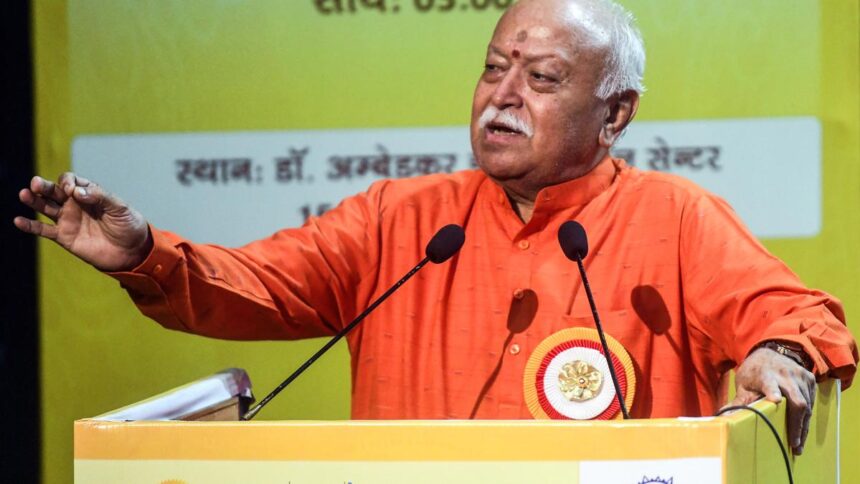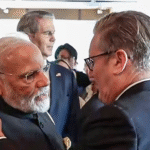‘Bharatiyata Is the Only Solution to Global Challenges Today,’ Says RSS Chief Mohan Bhagwat
A World in Flux, A Voice from Within
In an age defined by ideological clashes, climate anxiety, deepening polarization, and rising alienation, calls for a moral and cultural compass are growing louder across continents. From the disillusionment of Western liberal democracies to the unrest triggered by authoritarian resurgence, global systems appear to be at a crossroads. Amid this uncertainty, a statement from Rashtriya Swayamsevak Sangh (RSS) Chief Mohan Bhagwat resounded with unmistakable conviction:
“Bharatiyata is the only solution to all the problems the world is facing today.”
Delivered in a national context, yet aspiring for global resonance, this assertion invites deep analysis: What is Bharatiyata? How can a civilizational idea from India claim relevance across the globe? And what does it mean in practice—socially, politically, economically, and spiritually?
Bharatiyata: Beyond Nationalism, Towards Civilizational Identity
At its core, Bharatiyata is not merely nationalism. It transcends the boundaries of statehood and enters the terrain of civilizational ethos—a millennia-old worldview rooted in pluralism, spirituality, sustainability, and interconnectedness.
The term itself is drawn from ‘Bharat’, the indigenous name for India, used since ancient times in scriptures like the Mahabharata and the Puranas. But Bharatiyata is not a chauvinistic assertion of identity; rather, it suggests a value system shaped by Indian tradition, including but not limited to:
- Vasudhaiva Kutumbakam: The world is one family
- Sarva Dharma Sambhava: Equal respect for all religions
- Ahimsa: Non-violence as a moral principle
- Seva: Service as a civic and spiritual duty
- Dharma: Ethical balance and cosmic order
Bhagwat’s vision positions Bharatiyata as an antidote to global ailments—be it ecological collapse, economic inequality, or civilizational despair. But this claim must be unpacked with intellectual honesty and historical depth.
The Global Crises That Frame the Statement
Bhagwat’s speech did not occur in a vacuum. The world in 2025 continues to grapple with multiple overlapping crises:
- Geopolitical Tensions: The Russia-Ukraine war shows no signs of resolution, while the Middle East remains unstable due to new confrontations between Iran and Israel.
- Environmental Distress: Record-breaking temperatures, floods, and wildfires have left entire populations displaced and ecosystems degraded.
- Mental Health Epidemic: From loneliness in affluent societies to hopelessness in conflict zones, human well-being is under siege.
- Crisis of Faith in Institutions: Governments, media, and even scientific authorities are facing a trust deficit across democracies and autocracies alike.
In this backdrop, Bhagwat’s assertion of Bharatiyata as a remedy gains traction—not just as cultural rhetoric, but as a civilizational proposal to reimagine human coexistence.
Philosophical Roots: The Indic View of the Self and Society
Bharatiyata draws heavily from Indic philosophical traditions, particularly Sanatana Dharma, Buddhism, Jainism, and Sikhism. Unlike Western thought which often emphasizes individual vs society, Indian traditions see the self (atman) as connected to the universal (Brahman).
This worldview brings forward three radical departures from modern paradigms:
- Inner Reform Precedes Outer Change: Solutions begin with the individual’s dharmic alignment, not just policy interventions.
- Nature Is Not a Resource—It Is a Relative: The Earth (Prithvi), rivers (Ganga, Yamuna), and even animals (Gau Mata, Nag) are revered as kin.
- Spiritual Pluralism as Foundation: Truth is one, sages call it by different names—Ekam sat vipra bahudha vadanti.
In essence, Bharatiyata offers a spiritualized ethic of engagement with the world, in contrast to the materialist and anthropocentric models that dominate international systems.
Bhagwat’s Intent: A Response to Cultural Rootlessness
RSS Chief Mohan Bhagwat has often spoken about preserving cultural continuity in the face of what he terms Westernization without roots. In his 2025 speech, the concern was not merely about India imitating the West, but the West losing its own moral compass, thereby exporting emptiness masked as modernity.
His call for Bharatiyata, therefore, is a call for rootedness—a return to value-based living grounded in Indian tradition, without rejecting global progress. It’s not about isolationism; it’s about civilizational confidence.
Bhagwat emphasized that embracing Bharatiyata doesn’t mean uniformity, but unity in diversity. In that, he echoed the very foundation of Indian pluralism.
Beginning a Long Civilizational Journey
As the first part of this extensive series, we have set the tone by exploring the foundations, intent, and immediate context behind Bhagwat’s statement. Bharatiyata, as invoked by the RSS chief, is not merely a slogan—it is an ideological blueprint, a moral argument, and a cultural framework being offered to a world adrift in confusion.
If Bharatiyata is proposed as a universal cure to global ills, the first proving ground must be its own soil—India. The philosophies that support Bharatiyata, including unity in diversity, non-violence, dharma (righteous living), and spiritual pluralism, are deeply embedded in Indian thought. But how are these ideals implemented in modern India, a country that simultaneously celebrates its ancient legacy while navigating the demands of a fast-changing world?
In this part, we examine the institutional expressions, socio-political movements, policy alignments, and cultural shifts that claim to embody or promote Bharatiyata—and assess whether they uphold its values or dilute them for ideological convenience.
Bharatiyata in Governance: From Cultural Policy to National Narrative
The Indian government—especially under Prime Minister Narendra Modi—has increasingly invoked civilizational themes in governance. From restoring ancient monuments and renaming roads to internationalizing yoga and promoting Ayurveda, there is a clear attempt to mainstream Bharatiya heritage into policy.
- National Education Policy (NEP) 2020: A major policy move intended to revive Indic knowledge systems, Sanskrit, and traditional pedagogies while integrating modern skills.
- Swachh Bharat Abhiyan (Clean India Mission): Framed as a Gandhian civilizational value, this campaign sought to connect sanitation with dignity—a dharmic lens on cleanliness.
- Digital India with Dharma: Government apps for meditation, Sanskrit e-learning, and ISRO’s showcasing of ancient astronomy highlight how ancient knowledge is being technologically updated.
However, critics argue that this government-led Bharatiyata often overlaps with political Hindu nationalism, raising concerns over inclusivity, minority rights, and the secular fabric.
Cultural Revivals and Their Contradictions
Across India, there has been a rise in grassroots cultural movements aimed at reconnecting citizens to Bharatiya roots. From tribal language preservation in Odisha to organic farming based on Vedic texts in Maharashtra, people are rediscovering indigenous frameworks in education, agriculture, and art.
Examples include:
- Kumbh Mela Digitization Projects: Leveraging tech to manage ancient pilgrimages while maintaining their spiritual core.
- Local Temple Revivals: In Tamil Nadu and Karnataka, village-level initiatives have restored ancient shrines using crowdfunding, invoking Bharatiyata as both a cultural and spiritual duty.
- Art and Craft Empowerment: Reviving Madhubani, Warli, and Channapatna crafts not just for profit but as expressions of dharmic aesthetics.
Yet the revivalist wave is not without tension. Sometimes these movements become exclusionary, portraying non-Hindu or non-Sanskritic traditions as “less Indian,” which runs counter to the pluralistic essence of Bharatiyata.
Education: Knowledge as a Dharmic Duty
One of the most transformative spheres for Bharatiyata is education. The RSS and its affiliate bodies like Vidya Bharati have long advocated an education system rooted in Indian values, mother tongue instruction, and the teaching of dharmic ethics.
The Bharatiya Shikshan Mandal, for instance, champions a curriculum that includes:
- Bhagavad Gita studies
- Indian philosophical schools (Nyaya, Mimamsa, Vedanta)
- Yoga, Sanskrit, and Vedic mathematics
- Stories of Indian scientists, poets, saints, and reformers
But here too, balance is essential. When education becomes too ideological or pushes a singular narrative of Indian history (especially a majoritarian one), it risks becoming indoctrination instead of liberation—something Bharatiyata, in its truest form, would resist.
Women, Caste, and Social Equity: Bharatiyata’s Ethical Challenge
For Bharatiyata to be a credible model for the world, it must confront India’s own internal injustices. The caste system, gender inequality, and communal violence all represent fractures in the dharmic order.
Bhagwat himself, in recent speeches, has acknowledged that caste discrimination has no place in Bharatiyata, calling for its complete eradication. This has led to notable shifts:
- Dalit saints and reformers being celebrated more widely in mainstream curricula and temples.
- Women’s roles in rituals are being revisited, with more temples allowing female priests and menstruating women.
- RSS shakhas for women, once rare, are now growing in number to promote inclusive nation-building.
But the pace of reform remains inconsistent. While ideology promotes harmony, practice still reflects social inertia and occasional political exploitation, especially during elections.
Spiritual Pluralism and the Minority Question
One of the cornerstones of Bharatiyata is its deep commitment to pluralism. Historically, India has been a safe haven for Jews, Parsis, Tibetan Buddhists, and more. This ethos is enshrined in the philosophy of Sarva Dharma Sambhava.
However, in the present climate, minority communities—particularly Muslims and Christians—have raised concerns about cultural marginalization and increasing majoritarian rhetoric.
To fulfill its global promise, Bharatiyata must make room for:
- Multiple religious identities coexisting respectfully
- Protection of linguistic and cultural minorities
- Resistance to homogenizing tendencies, even if they come from well-intentioned nationalism
Only then can Bharatiyata be seen as a civilizational offering, not a cultural imposition.
Between Ideal and Reality
Bharatiyata in theory is deeply attractive—a plural, ethical, environmentally conscious, spiritually rich framework for living. But in practice, its success within India is uneven. It has inspired powerful reforms, fostered a cultural renaissance, and brought dharmic values into public life. Yet, it is also vulnerable to appropriation, misrepresentation, and politicization.
If Bharatiyata is to be India’s gift to the world, India must first fully live by its values—by ensuring justice, equity, and harmony within. Only then can the message of Bharatiyata resonate across continents as more than cultural diplomacy—it must become a living testimony of how civilization can heal itself and offer hope to others.
In 1996, political scientist Samuel Huntington predicted a future shaped not by ideology or economics, but by a “clash of civilizations.” East vs. West, Islam vs. Christendom, Confucianism vs. Liberalism—this was the framework that shaped global discourse post-Cold War.
However, in a rapidly multipolar, post-pandemic world fractured by climate crises, wars, and identity politics, a new question arises: Can civilizational philosophies like Bharatiyata offer a unifying alternative to ideological conflict?
In this part, we delve deep into:
- A comparative analysis between Bharatiyata, Western liberalism, Chinese collectivism, and Islamic universalism
- The philosophical, ethical, and civilizational distinctions Bharatiyata brings to global discourse
- Whether Bharatiyata can be a model—not just for India, but for humanity
Bharatiyata vs. Western Liberalism: Freedom vs. Responsibility
Western liberalism, with its emphasis on individual rights, secularism, and capitalism, has dominated global institutions for centuries. Rooted in Enlightenment thought, it champions liberty, rationalism, and market freedom.
Bharatiyata, by contrast, centers around dharma, which places duty above rights, and interdependence above individualism.
| Dimension | Western Liberalism | Bharatiyata |
|---|---|---|
| Core Value | Freedom | Dharma (ethical responsibility) |
| Ontology | Individual-centric | Community and cosmos-centric |
| Spiritual Framework | Secular or agnostic | Pluralistic and spiritually integrated |
| Economic Ethos | Capitalist/materialist | Spiritual-material balance (Artha + Dharma) |
While Western liberalism gives unmatched agency to the individual, it often struggles with ecological limits, alienation, and hyper-competition. Bharatiyata offers a corrective—not by rejecting freedom, but by balancing it with responsibility.
Bharatiyata vs. Chinese Collectivism: Harmony vs. Control
China’s civilizational model, especially under the Communist Party, promotes collectivist stability, centralized governance, and a Confucian ethic of social order.
Bharatiyata, though community-focused, rejects authoritarian control. Its vision of harmony is spiritual and voluntarily ethical, not state-imposed.
| Dimension | Chinese Model | Bharatiyata |
|---|---|---|
| State-Citizen Relation | Centralized & paternalistic | Decentralized, family-tribe rooted |
| Individual Freedom | Secondary to state goals | Balanced with moral responsibility |
| Technological Ethic | Surveillance-driven control | Tech as a tool for liberation (if dharmic) |
In short, China engineers harmony, while Bharatiyata inspires harmony through consciousness. One is managed peace, the other is awakened peace.
Bharatiyata vs. Islamic Universalism: Unity vs. Plurality
Islamic universalism, especially in its political expressions, envisions a unified Ummah, governed by divine law (Sharia) across boundaries.
Bharatiyata, in contrast, rejects totalizing frameworks. While deeply spiritual, it accepts multiple paths to truth—Advaita, Bhakti, Buddhism, Jainism, Sikhism, tribal animisms, even atheism.
| Dimension | Islamic Universalism | Bharatiyata |
|---|---|---|
| View of God | Monotheistic (Allah) | Pluralistic (Brahman, Ishta Devatas, none) |
| Legal Code | Sharia-based jurisprudence | Contextual dharma, not universal law |
| Vision of Society | Ummah (unified Muslim world) | Vishwa Kutumbakam (world as one family) |
While Islam emphasizes universal submission to one God, Bharatiyata invites personal communion with the divine in multiple forms—a radically inclusive vision that offers coexistence without uniformity.
The Distinctiveness of Bharatiyata in the 21st Century
Amid global crises—climate change, AI ethics, migration conflicts, mental health epidemics, and ideological polarization—Bharatiyata’s ancient yet evolving framework offers unique contributions:
- Ecological Dharma: The idea that nature is sacred (Prakriti is Shakti) could reshape environmental ethics globally.
- Mindful Modernity: By integrating meditation, yoga, and self-inquiry, Bharatiyata counters the mental health fallout of modernity.
- Post-Colonial Confidence: It encourages decolonizing knowledge systems, empowering indigenous thought worldwide.
- Democratic Spirituality: Unlike theocratic models, Bharatiyata blends democracy with spirituality without enforcing dogma.
Can Bharatiyata Lead Without Conquering?
One critical test remains: Can Bharatiyata expand globally without imperial ambition?
Unlike the Western missionary zeal or the Chinese Belt & Road expansion, Bharatiyata’s transmission must remain invitational, not prescriptive.
- Yoga’s global acceptance came not from coercion, but resonance.
- Ayurveda and Indian philosophy spread through seekers, not soldiers.
- Buddhism’s worldwide reach happened under the same Bharatiya ethic: persuasion through compassion, not conversion.
If India exports Bharatiyata with humility, openness, and integrity, it can be a global civilizational offering rather than a nationalist export.
The Civilizational Compass for a Fragmented World
Bharatiyata is not a competitor in a civilizational arms race. It is a third path—a civilizational ethic that transcends both aggressive modernity and dogmatic tradition. It harmonizes freedom and duty, individuality and interconnectedness, progress and preservation.
In the 21st century, where climate collapse, war, loneliness, and extremism threaten our shared future, Bharatiyata offers not slogans but soulful solutions. Its success depends not on geopolitical dominance, but on its capacity to reawaken human consciousness everywhere—in India and beyond.
Even before Mohan Bhagwat’s assertion placed Bharatiyata at the heart of global discourse, the civilizational soul of India had already begun to permeate global consciousness—not through conquest or campaigns, but through curiosity, crises, and cultural evolution.
From yoga studios in California to AI ethics think tanks in Germany, and from African ancestral revival movements to Latin American ecological communities, the Bharatiya worldview is increasingly seen as a living template for balancing material advancement with spiritual grounding.
In this part, we will examine:
- How Bharatiyata influences global education, spirituality, psychology, governance, and technology
- The adaptation of Indic principles in the West, Africa, Latin America, and Southeast Asia
- How Bharatiyata is being reimagined by non-Indian thinkers, leaders, and reformers
Bharatiyata in Western Thought: A Soft Revolution in the Mind
Yoga, Meditation & Neuroscience:
Over 300 million people worldwide practice yoga today. Originally seen as mere exercise, yoga has become a gateway to Bharatiya metaphysics, prompting deeper inquiries into meditation, Vedanta, and Ayurveda.
Institutions like Harvard, Stanford, and Oxford have dedicated programs studying the neurological and psychological benefits of:
- Dhyana (Meditation)
- Pranayama (Breath control)
- Satvik lifestyle (Conscious living)
This is not just cultural borrowing—it’s a civilizational conversation. Western medicine is beginning to accept what Bharatiyata has long known: the mind and body are not separate; consciousness is central.
Psychology Meets Dharma:
Psychologists like Carl Jung were deeply influenced by Indian thought, especially the Upanishads and the Bhagavad Gita. Today, depth psychology, trauma therapy, and psychedelic-assisted healing are looking back to Bharatiya frameworks of karma, samskara, and moksha.
Bharatiyata in Africa: The Rediscovery of Civilizational Roots
In African nations like Ghana, Kenya, and Nigeria, indigenous scholars and spiritual leaders are recognizing parallels between Bharatiya dharmic ideas and African tribal cosmologies:
| African Belief | Bharatiya Equivalent |
|---|---|
| Ubuntu (I am because we are) | Vasudhaiva Kutumbakam (World is one family) |
| Ancestral Reverence | Pitru Tarpana (Ancestral rituals) |
| Nature Spirits | Devi/Shakti traditions |
| Oral epics | Itihasas like Mahabharata, Ramayana |
This has led to new intellectual movements like “Afro-Vedic synthesis”, where African heritage and Indian metaphysics are studied side by side to reconstruct post-colonial civilizational identity.
Bharatiyata in Latin America: Ecology Meets Dharma
Latin American communities, particularly in Brazil, Colombia, and Peru, are facing ecological and spiritual disintegration due to deforestation, drug wars, and urban poverty. Bharatiyata is arriving there not via sermons but through sustainability movements:
- Permaculture farming based on Vaastu and Panchamahabhuta
- Ayurvedic diets in Andean wellness retreats
- Gita-based ethical leadership training for social workers
Leaders of Amazonian tribes have even collaborated with Indian yoga practitioners to blend shamanic and dharmic practices, creating hybrid rituals of healing, environmental stewardship, and inner awakening.
Bharatiyata in East and Southeast Asia: Ancestral Wisdom Rekindled
In countries like Indonesia, Thailand, Cambodia, and Japan, Bharatiyata is not a foreign idea—it’s ancestral memory.
- Bali retains pre-Islamic Bharatiya traditions of Ramayana and Ganesha worship
- Thailand’s monarchy draws legitimacy from ancient Hindu-Buddhist cosmology
- Japan’s Zen has roots in Indian dhyana transmitted via China
In all these cultures, Bharatiyata is being revived not as Indian nationalism, but as civilizational memory. It inspires new generations to balance high technology with traditional dharma.
The Global Academic Turn Towards Bharatiyata
Elite universities across the world are now beginning to take Bharatiya civilizational thought seriously—not just in religious studies, but in politics, psychology, sustainability, and AI ethics.
- University of Chicago has launched a course titled: Dharmic Governance: Non-Western Political Philosophy
- MIT’s AI Lab studies ancient Indian logic (Nyaya) for next-gen machine reasoning
- Heidelberg University (Germany) is researching Gita-based ethics in leadership models
Bharatiyata is being repositioned not as religious folklore, but as global civilizational intelligence—capable of solving 21st-century dilemmas.
Challenges and Misinterpretations
While Bharatiyata gains traction globally, it’s often misunderstood, diluted, or politicized:
- Cultural Appropriation: Yoga without dharma becomes a mere fitness routine.
- Political Projection: Equating Bharatiyata only with Hindu nationalism alienates global audiences.
- Simplification: Complex ideas like karma or moksha are oversimplified into memes and Instagram quotes.
The responsibility lies with both India and the world to protect the integrity of Bharatiya thought, while making it accessible.
A Silent Awakening
Across continents, disciplines, and traditions, a silent awakening is underway. The Bharatiya civilizational impulse—not as religion, not as ideology, but as a way of being—is rising in relevance.
Not by design, not by diplomacy, but through the inherent thirst in human consciousness for truth, harmony, and rooted modernity.
Also Read : India-UK Trade Deal: Who Gains What in Cars, Whisky, and More During PM Modi’s Visit








